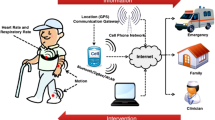Abstract
Intelligent bio-sensor information processing was developed using lifelog based context aware technology to provide a flexible and dynamic range of diagnostic capabilities to satisfy healthcare requirements in ubiquitous and mobile computing environments. To accomplish this, various noise signals were grouped into six categories by context estimation and effectively reconfigured noise reduction filters by neural network and genetic algorithm. The neural network-based control module effectively selected an optimal filter block by noise context-based clustering in running mode, and filtering performance was improved by genetic algorithm in evolution mode. Due to its adaptive criteria, genetic algorithm was used to explore the action configuration for each identified bio-context to implement our concept. Our proposed Bio-interactive healthcare service system adopts the concepts of biological context-awareness with evolutionary computations in working environments modeled and identified as bio-sensors based environmental contexts. We used an unsupervised learning algorithm for lifelog based context modeling and a supervised learning algorithm for context identification.







Similar content being viewed by others
References
Abowd, G. D. (1999). An experiment with the instrumentation of a living educational environment. IBM Systems Journal, 38(4), 508–530.
Celentano, A., & Gaggi, O. (2006). Context-aware design of adaptable multimodal documents. Multimedia Tools and Application, 29, 7–28.
Chung, K. Y. (2013). Effect of facial makeup style recommendation on visual sensibility. Multimedia Tools and Applications, doi:10.1007/s11042-013-1355-6.
Chung, K. Y., Yoo, J., & Kim, K. J. (2013). Recent trends on mobile computing and future networks. Personal and Ubiquitous Computing, doi:10.1007/s00779-013-0682-y.
Goldberg, D. (1989). Genetic algorithm in search, optimization, and machine learning (1st ed.). Boston: Addison-Wesley.
Gomez, A., Fernandez, M., & Corch, O. (2004). Ontological engineering (2nd ed.). New York, Berlin, Heidelberg.
Gonzalez, R. C., & Woods, R. E. (1993). Digital image processing. Reading: Addison Wesley.
Jung, Y. G., Han, M. S., Chung, K. Y., & Lee, S. J. (2011). A study of a valid frequency range using correlation analysis of throat signal. Information-An International Interdisciplinary Journal, 14(11), 3791–3799.
Kang, S. K., Kim, J. H., Chung, K. Y., Ryu, J. K., Rim, K. W., & Lee, J. H. (2012). Evolutionary bio-interaction knowledge accumulation for smart healthcare. In Proceedings of the 2th international conference IT convergence and security 2012, LNEE 215, pp. 425–432, 2012.
Kim, S. H., & Chung, K. Y. (2013). 3D simulator for stability analysis of finite slope causing plane activity. Multimedia Tools and Applications, doi:10.1007/s11042-013-1356-5.
Kim, J. H., & Chung, K. Y. (2013). Ontology-based healthcare context information model to implement ubiquitous environment. Multimedia Tools and Applications, doi:10.1007/s11042-011-0919-6.
Kim, J. H., Lee, D., & Chung, K. Y. (2013). Item recommendation based on context-aware model for personalized u-healthcare service. Multimedia Tools and Applications, doi:10.1007/s11042-011-0920-0.
Kuncheva, L. I., & Jain, L. C. (2000). Designing classifier fusion systems by genetic algorithms. IEEE Transactions on Evolutionary Computation, 4(4), 327–336.
Lee, M. S. (2004). Relationship of the relative risks of the metabolic syndrome and dietary habits of middle-aged in seoul. Korean J Community Nutr, 9(6), 695–705.
Lee, K. D., Nam, M. Y., Chung, K. Y., Lee, Y. H., & Kang, U. G. (2013). Context and profile based cascade classifier for efficient people detection and safety care system. Multimedia Tools and Applications, 63(1), 27–44.
Liu, C., & Wechsler, H. (2000). Evolutionary pursuit and its application to face recognition. IEEE Transactions on Pattern Analysis and Machine Intelligence, 22(6), 570–582.
MIT-BIH Database Distribution, http://ecg.mit.edu/.
Moghaddam, B., Nastar, C., & Pentland, A. (1996). A Bayesian similarity measure for direct image matching. In Proceedings of the 13th international conference on pattern recognition.
Moody, G., & Mark, R. (2001). The impact of the MIT-BIH Arrhythmia database. IEEE Engineering in Medicine and Biology, pp. 45–50.
Mori, N., Kude, T., & Matsumoto, K. (2000). Adaptation to a dynamic environment by means of the environment identifying genetic algorithm. Industrial Electronics Society IECON 2000, 26th Annual Conference of the IEEE, 4:2953–2958.
Ong, K. G., Dreschel, W. R., & Grimes, C. A. (2003). Detection of human respiration using square-wave modulated electromagnetic impulses. Microwave and Optical Technology Letters, 35, 339–343.
Pancer, T. P. (2004). A suppression of an impulsive noise in ECG signal processing. In Proceedings of the 26th annual international conference of the IEEE, engineering in medicine and biology society, pp. 596–599.
PhysioBank Archive Index, http://www.physionet.org/physiobank/database/#ecg.
Root, M., & Smith, T. (2005). Prescribe by risk: The utility of a biomarker-based risk calculation in disease management to prevent heart disease. Disease Management, 8(2), 106–113.
Slay, H., Thomas, B., Vernik, R., & Piekarski, W. (2004). A rapidly adaptive collaborative ubiquitous computing environment to allow passive detection of marked objects. Lecture Notes in Computer Science, 3101, 420–430.
Song, C. W., Lee, D., Chung, K. Y., Rim, K. W., & Lee, J. H. (2013). Interactive middleware architecture for lifelog based context awareness. Multimedia Tools and Applications, doi:10.1007/s11042-013-1362-7.
Song, C. W., Chung, K. Y., Jung, J. J., Rim, K. W., & Lee, J. H. (2011). Localized approximation method using inertial compensation in WSNs. Information-An International Interdisciplinary Journal, 14(11), 3591–3600.
Turk, M., & Pentland, A. (1991). Eigenfaces for recognition. Journal of Cognitive Neuroscience, 13(1), 71–86.
Yau, S., Wang, Y., & Karim, F. (2002). Development of situation-aware application software for ubiquitous computing environments. In Proceedings of the 26th international computer software and applications conference, pp. 233–238.
Yau, S. S., Wang, Y., Huang, D., & In, H. P. (2003) . A middleware situation-aware contract specification language for ubiquitous computing. In Proceedings of the 9th international workshop on future trends of distributed computing systems, Puerto Rico, USA, pp. 93–99.
Author information
Authors and Affiliations
Corresponding author
Additional information
This paper is significantly revised from an earlier version presented at the International Conference IT Convergence and Security.
Rights and permissions
About this article
Cite this article
Kang, SK., Chung, KY., Ryu, JK. et al. Bio-Interactive Healthcare Service System Using Lifelog Based Context Computing. Wireless Pers Commun 73, 341–351 (2013). https://doi.org/10.1007/s11277-013-1242-5
Published:
Issue Date:
DOI: https://doi.org/10.1007/s11277-013-1242-5




